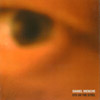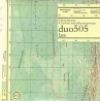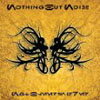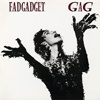North East Indie This Rosetta Stone of the Shoal catalog is finally re-released viatheir ever loyal current label for the first time since its vinyl-onlypressing in 1995. Their first 12" LP, originally self-released at 1000copies, shows the band at their earliest stages: a noodling,hard-edged, and often very derivative ensemble. Influences are so clearthey're transparent, with vocal performances almost ripped off frombands that were their contemporaries or their predecessors, anddynamics that bring to mind seminal recordings that helped shape orredefine whole genres of experimental music. Not to say that the bandisn't speaking with its own voice even on these songs, as there aretinges and aesthetics present that are still in play with their oeuvretoday, some ten years later. There is something to be said, though,that they were still searching for the right mix of the elements toinspire themselves and win over the masses. Maybe searching for theright members, as well, since the band is famous for a rotating cast ofcharacters that changed at least from album to album and sometimes inthe midst of recording one. At any rate, there's still a few momentsworthy of awe or discussion, and plenty to keep the mind racing on acold winter night. "Elena" has bright melodies and spoken word buriedin its subconscious, where "Change" leaves nothing below the surface orto the imagination, with explosive guitars, screams, and loud "oohs"that howl on and on as the heat increases. The key track, though, isthe penultimate "Breakaway Cable Terminal," with a gorgeous mix of theold and the new, the odd vocal performance mixed with the rawaggression but quieter jam moments framing both. There's even a hiddentrack, released presumably for the first time, as an added extra forthe loyalists. Cerberus Shoal are vital, original, and extreme, anduntil now some might have believed that it hasn't always been this way.Finally the truth can be told.
This Rosetta Stone of the Shoal catalog is finally re-released viatheir ever loyal current label for the first time since its vinyl-onlypressing in 1995. Their first 12" LP, originally self-released at 1000copies, shows the band at their earliest stages: a noodling,hard-edged, and often very derivative ensemble. Influences are so clearthey're transparent, with vocal performances almost ripped off frombands that were their contemporaries or their predecessors, anddynamics that bring to mind seminal recordings that helped shape orredefine whole genres of experimental music. Not to say that the bandisn't speaking with its own voice even on these songs, as there aretinges and aesthetics present that are still in play with their oeuvretoday, some ten years later. There is something to be said, though,that they were still searching for the right mix of the elements toinspire themselves and win over the masses. Maybe searching for theright members, as well, since the band is famous for a rotating cast ofcharacters that changed at least from album to album and sometimes inthe midst of recording one. At any rate, there's still a few momentsworthy of awe or discussion, and plenty to keep the mind racing on acold winter night. "Elena" has bright melodies and spoken word buriedin its subconscious, where "Change" leaves nothing below the surface orto the imagination, with explosive guitars, screams, and loud "oohs"that howl on and on as the heat increases. The key track, though, isthe penultimate "Breakaway Cable Terminal," with a gorgeous mix of theold and the new, the odd vocal performance mixed with the rawaggression but quieter jam moments framing both. There's even a hiddentrack, released presumably for the first time, as an added extra forthe loyalists. Cerberus Shoal are vital, original, and extreme, anduntil now some might have believed that it hasn't always been this way.Finally the truth can be told.
samples:
 Excellent use of dynamics is what allows this album to succeed. Topping 70 minutes, Eye on the Steel ranges from sparse, eerie crackling sounds to massive bursts of pulsating drones. There are 11 untitled tracks, but the set sounds as if it is one piece, with indexes placed at points at which there are major shifts in sound.
Excellent use of dynamics is what allows this album to succeed. Topping 70 minutes, Eye on the Steel ranges from sparse, eerie crackling sounds to massive bursts of pulsating drones. There are 11 untitled tracks, but the set sounds as if it is one piece, with indexes placed at points at which there are major shifts in sound.
Morr Collaborations have sometimes strengthened the work of the artistsinvolved, and have expanded their sometimes limited reach, but oftentimes they are also lackluster, producing yet more doubt anduncertainty as well as boredom in the clicks and blips that fly out ofthe speakers and through the air. Duo505 do not have such problems, asthe music contained on their debut is a perfect collaboration wheremaestros and messrs. B. Fleischmann and Herbert Weixelbaum take turnswaxing philosophical to transcend their own individual sound. One ofthe two will produce a track and send it to the other, where a secondtrack is added of the second collaborator's design. Two tracks, each anextension of the other — even though they were made at separate times —that merge in and out of each other's safe space in a truly dynamic andunique waver. Almost imperceptible is each man's part in theproceedings, but it's as though one handles the beat and melody, andthe other the trimmings, then vice versa on the following track. Thesetwo know each other so well that it is an almost effortless creation ofcerebral concoctions. "Nochwas" is ready for the clubs, a trounce andbounce frolic that soars and thumps at the same time; "Facing It" is ametallurgist nightmare of clangs and rolls that still mesmerizes.Through every track there is a connection that can't be underestimated,and live these two must be a treat to behold. On record, they arenothing short of a vision, or, like the Trans Am track title says, asingle ray of light on an otherwise cloudy day.
Collaborations have sometimes strengthened the work of the artistsinvolved, and have expanded their sometimes limited reach, but oftentimes they are also lackluster, producing yet more doubt anduncertainty as well as boredom in the clicks and blips that fly out ofthe speakers and through the air. Duo505 do not have such problems, asthe music contained on their debut is a perfect collaboration wheremaestros and messrs. B. Fleischmann and Herbert Weixelbaum take turnswaxing philosophical to transcend their own individual sound. One ofthe two will produce a track and send it to the other, where a secondtrack is added of the second collaborator's design. Two tracks, each anextension of the other — even though they were made at separate times —that merge in and out of each other's safe space in a truly dynamic andunique waver. Almost imperceptible is each man's part in theproceedings, but it's as though one handles the beat and melody, andthe other the trimmings, then vice versa on the following track. Thesetwo know each other so well that it is an almost effortless creation ofcerebral concoctions. "Nochwas" is ready for the clubs, a trounce andbounce frolic that soars and thumps at the same time; "Facing It" is ametallurgist nightmare of clangs and rolls that still mesmerizes.Through every track there is a connection that can't be underestimated,and live these two must be a treat to behold. On record, they arenothing short of a vision, or, like the Trans Am track title says, asingle ray of light on an otherwise cloudy day.
samples:
ICR Steven Stapleton and Colin Potter's voluntary three-month banishment tothe icy realms of Lofoten, Norway has borne fruit in the form of thisdouble album on ICR. As was reported, these two prime movers ofexperimental sound were sent high above the Arctic Circle May throughJuly of this year, with limited recording equipment and no musicalinstruments, to record a series of audio responses to their harshenvironment, which were then transmitted to the local mariner's radiostation at unannounced intervals. Stapleton and Potter have furtheredited and processed the original broadcasts, ending up with a total oftwo hours of sound, seven lengthy tracks. Shipwreck Radioworks best when Stapleton and Potter seem to be genuinely interactingand responding to their alien, inhospitable environment, rather thanfalling back on familiar NWW strategies. The microcosmic sound world ofice slowly melting and cracking apart merge with the lonely, distantcalls of arctic seabirds on the compelling "June 17," which slowlybackslides into glacial crevasse where a mutually indecipherableconversation between Stapleton and a Norwegian child is repeatedlylooped and mutated. Each track is named for the date that it wasbroadcast, and a handy map of the Lofoten Archipelago is printed on thediscs themselves, showing the geographical location where eachrecording was made. When the artists seem to be most engaged with theirenvironment — forming makeshift percussion out of blocks of ice, partsof vessels and disused metal scrap and transforming recordings ofarctic creatures, water runoff and wind tunnel noises into organicdrones — Shipwreck Radio really clicks as an album and aconcept. On the opposite end of the spectrum are tracks like thealbum's opener "June 15," which renders the source recordingscompletely unrecognizable, digitally processing them into a distorted,post-industrial rhythmic dirge that wears out its welcome well beforethe ten-minute mark has been reached. Colin Potter's droning muse seemsto have exerted a stronger influence on disc two, which exploitsenvironmental noises and subtle looping and processing to createtextural expanses of beautifully chilly ambience. "June 5" sounds likean orchestra slowly succumbing to the pulse-deadening effects ofhypothermia, stretching out each chord to epic lengths, as ever moreminute bits of audio detritus pan around the stereo channels. As thealbum trudges on, things become darker, more menacing and moresluggish, perhaps as a result of the inevitable fatigue experienced insuch a hostile environment where the sun unmercifully shines for nearly24 hours each day. There is an organic, impromptu feel to much of thismusic that lends it an immediacy not usually experienced with NurseWith Wound music, which often seems rather painstakingly processed,mutated and generally tortured to within an inch of its life. Thishelps the album operate as a sort of freeform travelogue or audiodiary. The first edition of 100 copies came with a bonus disc, Lofoten Deadhead(a reference to the excerpted bit of Norwegian radio where a localexplains why the Grateful Dead is "the ultimate band"), which containsmore variations on the same audio sources, as well as a 30-minute trackof untreated recordings of Stapleton and Potter experimenting withdifferent methods of creating compelling noises from theirsurroundings, fussing about with objects and arguing with each other.It's unfortunate that this was not included on the album proper, as itis both entertaining and provides a glimpse into the duo's workingmethods that enriches the material on the other two discs. Takentogether, even with its momentary lapses of originality, Shipwreck Radio is a fascinating entry in both artists' substantial discographies.
Steven Stapleton and Colin Potter's voluntary three-month banishment tothe icy realms of Lofoten, Norway has borne fruit in the form of thisdouble album on ICR. As was reported, these two prime movers ofexperimental sound were sent high above the Arctic Circle May throughJuly of this year, with limited recording equipment and no musicalinstruments, to record a series of audio responses to their harshenvironment, which were then transmitted to the local mariner's radiostation at unannounced intervals. Stapleton and Potter have furtheredited and processed the original broadcasts, ending up with a total oftwo hours of sound, seven lengthy tracks. Shipwreck Radioworks best when Stapleton and Potter seem to be genuinely interactingand responding to their alien, inhospitable environment, rather thanfalling back on familiar NWW strategies. The microcosmic sound world ofice slowly melting and cracking apart merge with the lonely, distantcalls of arctic seabirds on the compelling "June 17," which slowlybackslides into glacial crevasse where a mutually indecipherableconversation between Stapleton and a Norwegian child is repeatedlylooped and mutated. Each track is named for the date that it wasbroadcast, and a handy map of the Lofoten Archipelago is printed on thediscs themselves, showing the geographical location where eachrecording was made. When the artists seem to be most engaged with theirenvironment — forming makeshift percussion out of blocks of ice, partsof vessels and disused metal scrap and transforming recordings ofarctic creatures, water runoff and wind tunnel noises into organicdrones — Shipwreck Radio really clicks as an album and aconcept. On the opposite end of the spectrum are tracks like thealbum's opener "June 15," which renders the source recordingscompletely unrecognizable, digitally processing them into a distorted,post-industrial rhythmic dirge that wears out its welcome well beforethe ten-minute mark has been reached. Colin Potter's droning muse seemsto have exerted a stronger influence on disc two, which exploitsenvironmental noises and subtle looping and processing to createtextural expanses of beautifully chilly ambience. "June 5" sounds likean orchestra slowly succumbing to the pulse-deadening effects ofhypothermia, stretching out each chord to epic lengths, as ever moreminute bits of audio detritus pan around the stereo channels. As thealbum trudges on, things become darker, more menacing and moresluggish, perhaps as a result of the inevitable fatigue experienced insuch a hostile environment where the sun unmercifully shines for nearly24 hours each day. There is an organic, impromptu feel to much of thismusic that lends it an immediacy not usually experienced with NurseWith Wound music, which often seems rather painstakingly processed,mutated and generally tortured to within an inch of its life. Thishelps the album operate as a sort of freeform travelogue or audiodiary. The first edition of 100 copies came with a bonus disc, Lofoten Deadhead(a reference to the excerpted bit of Norwegian radio where a localexplains why the Grateful Dead is "the ultimate band"), which containsmore variations on the same audio sources, as well as a 30-minute trackof untreated recordings of Stapleton and Potter experimenting withdifferent methods of creating compelling noises from theirsurroundings, fussing about with objects and arguing with each other.It's unfortunate that this was not included on the album proper, as itis both entertaining and provides a glimpse into the duo's workingmethods that enriches the material on the other two discs. Takentogether, even with its momentary lapses of originality, Shipwreck Radio is a fascinating entry in both artists' substantial discographies.
samples:
~scape For this jaded, disgruntled music critic, there is little more gratingthan a concept release that defines its intended strategy, executes iteffectively, and ultimately comes out sounding like a complete waste oftime and energy. With the aptly titled Nocturnes, False Dawns & Breakdowns,his second album for ~scape, Berlin-based Andrew Peklar quietly combatsthat all-too-common quandary with an ear-pleasing fusion of postmidnight jazz and electronic atmospheres. Drawing considerableinspiration from legends such as Miles Davis and Sun Ra, Peklarcomposes somber, mysterious noirish landscapes that both complement thethematic darkness and pay homage to his musical predecessors. The briefopening track "Here Comes The Night," a swaggeringly slow dirge, setsthe stage for the bulk of the consistently grim and pensive materialthat follows. From there, "Arches" leads with keyboard melodies anddrumming of increasing intensity, peaking with a near cacophony thatstill somehow maintains a sense of confident control. "Wait" introducessoft yet meaningful horn playing, treated with a delay that meshes wellwith the glitchy pastiche of percussive and airy elements. The quirkyand distinctly loop-based "Stardusting" specifically reminds of JanJelinek's work for the label with its sampler intermittently stutteringone specific section amidst the comparatively subtler cut-ups. "InCircles" toys with twinkling xylophone tones before fading into"Nocturne 3", where ambient noise bleeds through the deep bass anddisplaced voices, held together by a certain trip-hop sensibility."False Dawns" finds itself stuck between the preceeding tracks and adigital dub asthetic more characteristic of the ~scape roster, veeringat times into a soundtrack of the climax of some paranoiac sciencefiction film. Much like with labelmate Jan Jelinek's forward thinking Loop Finding Jazz Records,careful headphone-aided analysis of these tracks reveals approximateloop points and edit markers, though for true appreciation it should belistened to without quasi-scientific consideration of its technicalmake-up. While woefully concise at under 40 minutes, Nocturnes, False Dawns & Breakdownsacts as a brief window into a private world only found in the earlyhours, and only accessible to those willing to stay awake for it.
For this jaded, disgruntled music critic, there is little more gratingthan a concept release that defines its intended strategy, executes iteffectively, and ultimately comes out sounding like a complete waste oftime and energy. With the aptly titled Nocturnes, False Dawns & Breakdowns,his second album for ~scape, Berlin-based Andrew Peklar quietly combatsthat all-too-common quandary with an ear-pleasing fusion of postmidnight jazz and electronic atmospheres. Drawing considerableinspiration from legends such as Miles Davis and Sun Ra, Peklarcomposes somber, mysterious noirish landscapes that both complement thethematic darkness and pay homage to his musical predecessors. The briefopening track "Here Comes The Night," a swaggeringly slow dirge, setsthe stage for the bulk of the consistently grim and pensive materialthat follows. From there, "Arches" leads with keyboard melodies anddrumming of increasing intensity, peaking with a near cacophony thatstill somehow maintains a sense of confident control. "Wait" introducessoft yet meaningful horn playing, treated with a delay that meshes wellwith the glitchy pastiche of percussive and airy elements. The quirkyand distinctly loop-based "Stardusting" specifically reminds of JanJelinek's work for the label with its sampler intermittently stutteringone specific section amidst the comparatively subtler cut-ups. "InCircles" toys with twinkling xylophone tones before fading into"Nocturne 3", where ambient noise bleeds through the deep bass anddisplaced voices, held together by a certain trip-hop sensibility."False Dawns" finds itself stuck between the preceeding tracks and adigital dub asthetic more characteristic of the ~scape roster, veeringat times into a soundtrack of the climax of some paranoiac sciencefiction film. Much like with labelmate Jan Jelinek's forward thinking Loop Finding Jazz Records,careful headphone-aided analysis of these tracks reveals approximateloop points and edit markers, though for true appreciation it should belistened to without quasi-scientific consideration of its technicalmake-up. While woefully concise at under 40 minutes, Nocturnes, False Dawns & Breakdownsacts as a brief window into a private world only found in the earlyhours, and only accessible to those willing to stay awake for it.
samples:
 Mark McGee, formerly of To Kill A Petty Bourgeoisie, has partnered up with a new female vocalist, Nicole Tollefson, to follow the path he pioneered in his previous band, combining harsh, noisy electronics and guitar with pure, delicate female vocals to excellent effect, although it seems that the harsher end of the spectrum has been reigned in somewhat.
Mark McGee, formerly of To Kill A Petty Bourgeoisie, has partnered up with a new female vocalist, Nicole Tollefson, to follow the path he pioneered in his previous band, combining harsh, noisy electronics and guitar with pure, delicate female vocals to excellent effect, although it seems that the harsher end of the spectrum has been reigned in somewhat.
 Following up their acclaimed debut LP The Persistence of Meaning, this Brooklyn duo of Joshua Convey and Luke Krnkr serve up another release of dark, mysterious murk that channels krautrock as much as harsh noise. With an A side that goes for more musical elements, and a harsher, disjointed B side, the combination works wonderfully.
Following up their acclaimed debut LP The Persistence of Meaning, this Brooklyn duo of Joshua Convey and Luke Krnkr serve up another release of dark, mysterious murk that channels krautrock as much as harsh noise. With an A side that goes for more musical elements, and a harsher, disjointed B side, the combination works wonderfully.
 In an unexpected move, Front 242's Daniel Bressanutti has rejoined former member Dirk Bergen (who left soon after the Geography album) to start this new project, heavily rooted in classic analog synth technology and an apparent love of the Blade Runner soundtrack. While being spread across two discs comes across as excessive, there's still a good album’s worth of tracks in here.
In an unexpected move, Front 242's Daniel Bressanutti has rejoined former member Dirk Bergen (who left soon after the Geography album) to start this new project, heavily rooted in classic analog synth technology and an apparent love of the Blade Runner soundtrack. While being spread across two discs comes across as excessive, there's still a good album’s worth of tracks in here.
 For the final Fad Gadget album, Frank Tovey went to Berlin, home of touring mates Einstürzende Neubauten, and once again sought to expand the sound beyond the synth domination of prior releases. Unsurprisingly, the result incorporates much more abrasive percussive sources, but Tovey remained within his element of entertainer/commentator role when it came to the subject matter at hand.
For the final Fad Gadget album, Frank Tovey went to Berlin, home of touring mates Einstürzende Neubauten, and once again sought to expand the sound beyond the synth domination of prior releases. Unsurprisingly, the result incorporates much more abrasive percussive sources, but Tovey remained within his element of entertainer/commentator role when it came to the subject matter at hand.



